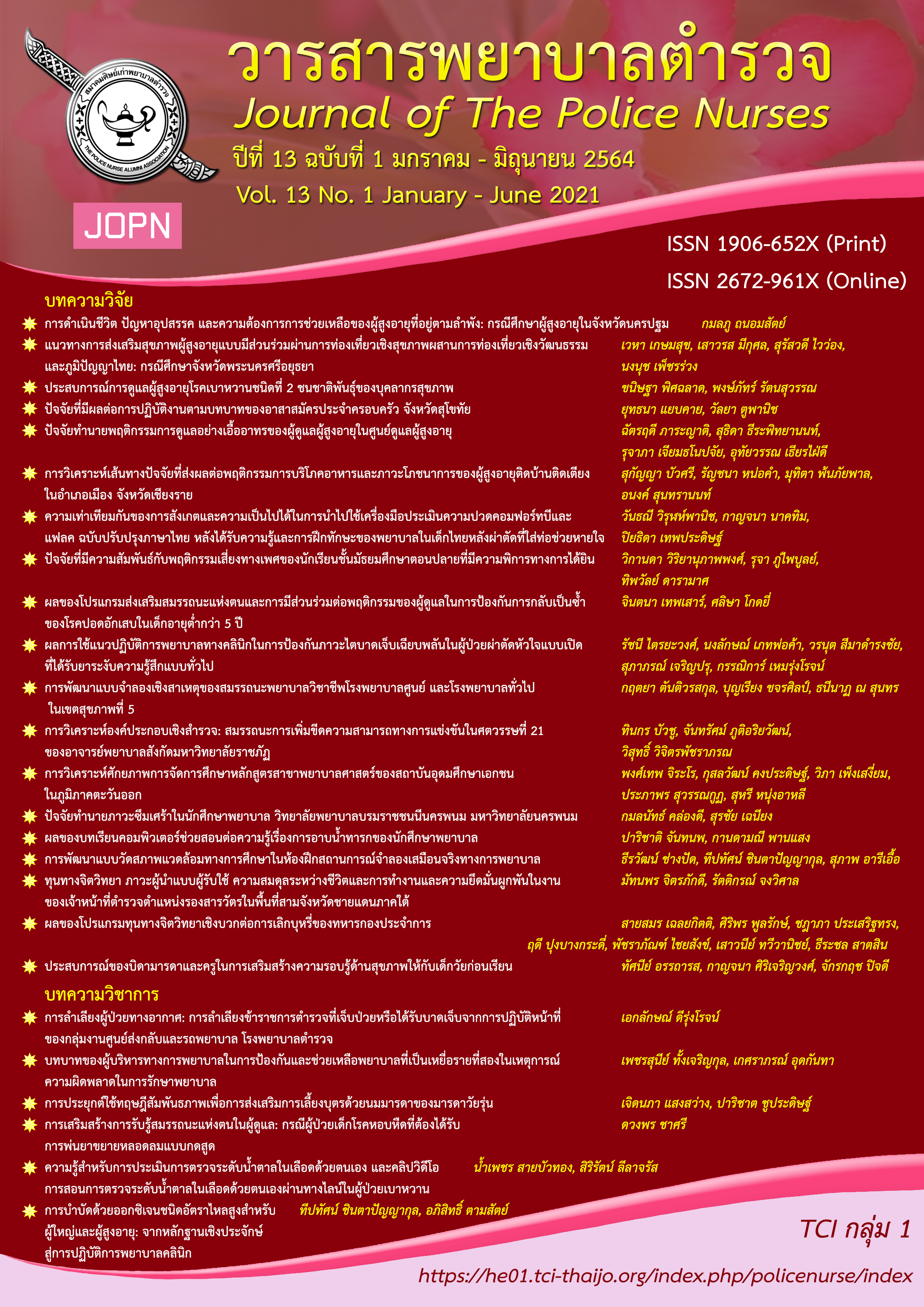FACTORS PREDICTING DEPRESSION IN NURSING STUDENTS AT BOROMARAJONANI COLLEGE OF NURSING NAKHONPHANOM, NAKHONPHANOM UNIVERSITY
Keywords:
Depression, Stress, Social support, Resilience, Nursing studentAbstract
The objective of this predictive research was to investigate the factors predicting depression in nursing students. A simple random sampling technique was used to recruit 311 nursing students from Boromarajonani College of Nursing Nakhon Phanom. A set of self-report questionnaires was used for data collection, including the Thai version of the Patient Health Questionnaire (PHQ-9), Suanprung Stress Test-20, Revised-Thai version of the Multi-dimensional Scale of Perceived Social Support, and Resilience Inventory. Internal consistency reliability for research instruments tested by Cronbach’s alpha were .92, .93, .84, and .92, respectively. Data were analyzed using descriptive statistics and stepwise multiple regression.
The findings revealed that stress, resilience, age, and social support accounted for 63 percent of variance of depression in nursing students (R2 = .63, R2Change = .62, F (4,310) = 128.09, p = .00). Stress was positively related to depression with statistical significance (r = .75, p = .00), while age, resilience, and social support were negatively related to depression with statistical significance (r = -.14, p = .02, r = -.52, p = .00, and r = -.39, p = .00, respectively).
Nursing instructors and other healthcare providers could develop a comprehensive program focusing on managing stress, enhancing social support, and maintaining resilience to prevent depression in nursing students.
Downloads
References
Allen, W. (2016). Examining the relationships between stress, depression, anxiety, and resilience in undergraduate nursing students (Master of science, clinical mental health counseling). University of North Georgia, USA.
Aradilla-Herrero, A., Tomás-Sábado, J., & Gómez-Benito, J. (2014). Associations between emotional intelligence, depression and suicide risk in nursing students. Nurse Education Today, 34(4), 520-525.
Chen, C. J., Chen, Y. C., Sung, H. C., Hsieh, T. C., Lee, M. S., & Chang, C. Y. (2015). The prevalence and related factors of depressive symptoms among junior college nursing students: A cross-sectional study. Journal of Psychiatric and Mental Health Nursing, 22(8), 590-598.
Cheung, T., Wong, S. Y., Wong, K. Y., Law, L. Y., Ng, K., Tong, M. T., . . . Yip, P. S. F. (2016). Depression, anxiety, and symptoms of stress among baccalaureate nursing students in Hong Kong: A cross-sectional study. International Journal of Environmental Research and Public Health, 13, 779.
Cohen, J. (1988). Statistical power analysis for the behavioral sciences (2nd ed.). New Jersey, NJ: Lawrence Erlbaum.
Dawood, E., Mitsu, R., Ghadeer, H. A., & Alrabodh, F. (2017). Assessment of depression and its contributing factors among undergraduate nursing students. International Journal of Nursing, 4(2), 69-79.
Facioli, A. M., Barros, A. F., Melo, M. C., Ogliari, I. C. M., & Custódio, R. J. M. (2018). Depression among nursing students and its association with academic life. Revista Brasileira de Enfermagem, 73(1), e20180173.
Grotberg, E. H. (1995). A guide to promoting resilience in children: strengthening the human spirit. Retrieved from https://bibalex.org/baifa/attachment/documents/115519.pdf
Grotberg, E. H. (1997). The international resilience project: Findings from the research and the effectiveness of interventions. Retrieved from https://files.eric.ed.gov/fulltext/ED419584.pdf
House, J. S. (1981). Work stress and social support. Reading, MA: Addison-Wesley.
Kaewmart, N. (2013). Nursing students with depression. The Journal of Faculty of Nursing Burapha University, 21(3), 14-23.
Kajai, C., & Namwong, A. (2019). Facebook addition, depression, and suicide risk among Z generation nursing students. Journal of Public Health Nursing, 33(2), 33-47.
Lotrakul, M., Sumrithe, s., & Saipanish, R. (2008). Reliability and validity of the Thai version of the PHQ-9. BMC Psychiatry, 8(46).
Mahatnirunkul, S., Pumpaisalchai, W., & Tapanya, P. (1997). Suanprung stress test. Chiangmai: Suanprung hospital.
Muenthaisong, S., Amornrojanavaravutti, W., & Ladla, A. (2018). Factors predicting mental health in nursing students. Journal of Nursing Science and Health, 41(2), 99-107.
Njim, T., Mbanga, C., Mouemba, D., Makebe, H., Toukam. L., Kika, B., & Mulango. (2020). Determinats of depression among nursing students in Camoeroon: A cross-sectional analysis. BMC Nursing, 29, 26.
Nintachan, P., Sangon, S., & Thaweekoon, T. (2012). A resilience-enhancing program. Bangkok: Judthong.
Pulido-Criollo, F. P., Cueto-Escobedo, J., & Guillén- Ruiz, G. (2018). Stress in nursing university students and mental health. Health and Academic Achievement, Blandina Bernal-Morales, Intech Open. https://doi.org/10.5772/intechopen.72993
Ratanasiripong, P. (2012). Mental health of Muslim nursing students in Thailand. International Scholarly Research Network Nurse, 2012(463471).
Rathnayake, A., & Ekanayaka, J. (2016). Depression, anxiety and stress among undergraduate nursing students in a public university in Sri Lanka. International Journal of Caring Sciences, 9(3), 1020-1031.
Ross, R., Wolf, L., Chiang-Hanisko, L., Tanaka, T., Takeo, K., Boonyanurak, P., . . . Seanyakul, P. (2014). Depression and its predictors among nursing students in four countries: USA, Thailand, Taiwan and Japan. Journal of The Royal Thai Army Nurses, 15(3), 195-201.
Samarksavee, N., & Sangon, S. (2015). Factors associated with depression in nursing students. The Journal of Psychiatric Nursing and Mental Health, 29(3), 11-27.
Tafet, G. E., & Nemeroff, C. B. (2016). The link between stress and depression: Psychoneuroendocrino-logical, genetic, and environmental interactions. Journal of Neuropsychiatry and Clinical Neuroscience, 28, 77-88.
Wongpakaran, N., & Wongpakaran, T. (2012). A revised Thai multi-dimensional scale of perceived social support. The Spanish Journal of Psychology, 15(3), 1503-1509.
World Health Organization. (2017). Depression and other common mental disorders: Global health estimates. Geneva, Switzerland: Author.
Xu, Y., Chi, X., Chen, S., Qi, J., Zhang, P., & Yang, Y. (2014). Prevalence and correlates of depression among college nursing students in China. Nurse Education Today, 34(6), e7-12.
Zimet, G. D., Dahlem, N. W., Zimet, S. G, & Faley, G. K. (1988). The multidimensional scale of perceived social support. Journal of Personality Assessment, 52(1), 34-41.
Downloads
Published
How to Cite
Issue
Section
License
ผลงานที่ได้ตีพิมพ์แล้วจะเป็นลิขสิทธิ์ของวารสารพยาบาลตำรวจ















